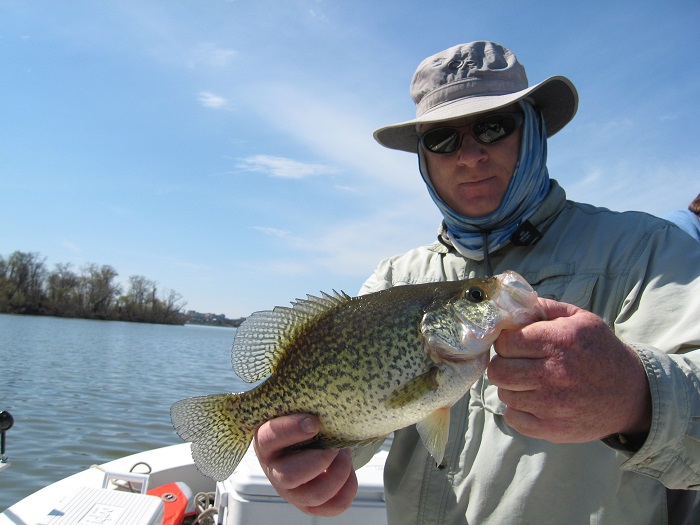
Maryland's Tidal Crappies
They say that March comes in like a lion and out like a lamb. So far this month March has been all “winter,” with below average temperatures and howling winds. But despite less than favorable conditions, there has been a slow but steady migration of one of the tastiest fish that swims in our Chesapeake Bay tributaries…that being the ever-popular crappie. Yes, Maryland has been blessed with tidal river systems on both the Western and Eastern Shores that support good populations of quality sized fish running 11 to 14-inches, and some much larger. Tidal systems such as the Upper Choptank, Nanticoke, Marsheyhope Creek, Wicomico, Blackwater, and the Pocomoke have historically yielded both size and numbers of black crappies on the Eastern Shore. Many smaller tributaries to these waters also see a springtime pulse of slab crappies and can yield banner catches during late March and well into April. On the western side of the Chesapeake Bay the many creeks, marina docks and backwaters off of the Potomac River see pre-spawn fish moving shallow usually by late March. With so much opportunity, March is the perfect time to head out with a group or the family for Maryland’s tidal crappies.

Tidal crappies move to shallow, gravel substrate areas to spawn once water temperatures reach the high fifty’s and are actively “on bed” when the water reaches 64 to 66 degrees Fahrenheit. The males make the initial spawning move by fanning a nest on sand or gravel bottoms, preferably near brush or wood structures. In tidal waters, crappies seek areas of minimal tidal influence away from main river currents. Often, dark or turbid waters of our tidal systems make it difficult to actually see bedding fish with polaroid glasses, so observe low-tide scenarios where proper spawning substrate is observed. The females will not be on the beds long, moving in to deposit their eggs at the proper time then leaving the spawning sites promptly. Dark, guardian males will remain on the beds and protect the newly hatched fry until they disperse on their own.
Tackle and Tactics
 Live Minnows
Live MinnowsLast year we fished with Captain Dave Snelling of Indian Head Charters in a vast backwater area of the Potomac River. He showed us the effectiveness of using long, telescoping poles to suspend live minnows below bobbers in search of pre-spawn crappies. He rigged the poles with 20-pound braided line and a 2-foot leader of 14-pound test monofilament. A #2 gold hook was used to lip and back-hook live minnows as we cruised around shallow, woody cover to locate the slabs. The baits were suspended 3 to 5 feet below bobbers depending on the location of the fish. This method, known as “spider-rigging” was just the ticket as we landed two dozen large crappies from 12 to over 14-inches along with a by-catch of largemouth bass, yellow perch and channel catfish. A week later we returned to the same area and I caught a “personal best” crappie that weighed 2 ½ pounds on a 1/16th ounce jig. Utilizing three poles per angler enabled us to cover a large swathe of water with the 16-foot sticks.
 Spider Rigging
Spider RiggingAlthough the spider-rigging technique was a real eye-opener for us, most of the time you can get by just fine with light or ultra-light spinning outfits with rods from 6 to 7 ½ feet. A 1000 series reel spooled with quality 4 or 6-pound test monofilament will cover most tidal crappie situations. We like to use a variety of 1/32nd and 1/16th ounce jigs with plastic tubes, twisters or straight-tailed plastics in a variety of colors. Black, white, chartreuse, and pink seem to be the most popular choices. Small bobbers from ¾ to 1 ½ inch in diameter suspend these lures nicely. You can cast tight to brush, fallen trees or other wood structures with or without the bobber and retrieve them slowly. Crappie strikes are often no more than a “bump”, so set the hook when you feel the tap.
Eastern Shore Options
[gallery columns="2" size="medium" link="none" ids="5204,5208"]
Across the Bay, Delmarva crappies often migrate upstream into creeks and tributaries and can often congregate in spillway pools below the many mill ponds during their spawning rituals. Tidal influences are minimal and often to the fish’s liking. Downstream from many of these pools or “tumble holes”, crappies will hole up in slackwater areas of minimal current and spawn there. The upper reaches of many river systems on the Eastern Shore present ideal options for kayak, canoe or small boat efforts to locate and catch fish. In many small towns throughout the region, tidal streams and “river walk” developments enable boat-less anglers to catch not just crappies but bass, pickerel, perch and some shad species as well. Additionally, trailering a fully-rigged boat is not needed to cash in on some Eastern Shore crappies.
If you want to plan a road trip or a long weekend in quest of Eastern Shore crappies, then the towns of Denton, Easton, and Salisbury have hotels, restaurants and a variety of angling options nearby. The tidal crappie bite holds up well into April on the Shore.
If you are interested in seeking Potomac River tidal crappie then two regional guide services offer trips. Contact Indian Head Charters, Inc. by calling Capt. Dave Snelling at 301-437-5333 or Capt. Mike Starrett at 202-439-1410, or visit www.indianheadcharters.com online.
Capt. Dennis Fleming also offers crappie fishing trips on the Potomac. Contact him online at www.fishamajigguideservice.com.
This post was written by Jim Gronaw
Images courtesy of the author